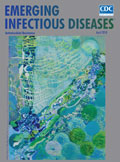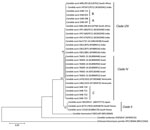
Volume 24, Number 4—April 2018
Research Letter
Candida auris Infection Leading to Nosocomial Transmission, Israel, 2017
On This Page
Ana Belkin, Zeala Gazit, Nathan Keller, Ronen Ben-Ami, Anat Wieder-Finesod, Ana Novikov, Galia Rahav, and Tal Brosh-Nissimov
Abstract
A patient transferred from South Africa to Israel acquired a Candida auris infection. Phylogenetic analysis showed resemblance of C. auris to isolates from South Africa but not Israel, suggesting travel-associated infection. C. auris infection occurred weeks later in another patient at the same hospital, suggesting prolonged environmental persistence.
Candida auris is a multidrug-resistant yeast that has emerged over the past 3 years to cause nosocomial outbreaks in multiple countries. C. auris can cause serious invasive infections, may spread between patients, and can survive for months on hospital room surfaces (1). Whole-genome sequencing has determined the presence of country-specific clades, which differ from one another by thousands of single-nucleotide polymorphisms (2). The mode of spread between countries remains unclear. We present a case of international C. auris transmission related to a medically repatriated patient.
A previously healthy 25-year-old Israeli man (patient A) was admitted to a hospital in Johannesburg, South Africa, after a motor vehicle accident on July 24, 2016. He had severe limb injury and underwent open reduction and internal fixation on both femurs, complicated by fat emboli, acute respiratory distress syndrome requiring mechanical ventilation, and ventilator-associated pneumonia. He was empirically treated with broad-spectrum antimicrobial drugs and caspofungin. Three weeks after the accident, he was transferred to the intensive care unit (ICU) of Sheba Medical Center, Tel Hashomer, Israel. Ten days after his arrival, a deep surgical-site infection developed in his left thigh. We initiated debridement and broad-spectrum antimicrobial drugs. After cultures obtained during surgery grew extended-spectrum β-lactamase–producing Klebsiella pneumoniae and meropenem-resistant Pseudomonas aeruginosa, we initiated contact isolation. Two of 3 deep-wound cultures grew C. auris. Two days later, 1 blood culture grew C. parapsilosis. We administered amphotericin B and appropriate antibacterial drugs, discontinuing amphotericin B after 10 days due to increased creatinine. The surgical site healed, and the patient was transferred to a rehabilitation unit. Rectal and skin surveillance cultures obtained 4 weeks after the first isolation of Candida were negative for C. auris. Routine ICU environmental disinfection included daily bleach cleaning of surfaces and quaternary ammonium wipes of sensitive medical equipment.
In January 2017, we isolated C. auris from a urine culture obtained through a catheter of a 70-year-old patient (patient B) who was admitted to the Sheba Medical Center ICU 6 weeks after the discharge of patient A. Patient B had not traveled abroad recently. Surveillance cultures (urine, axilla, perineum) of patients in the ICU at the time of C. auris isolation of either patient A or B were negative for C. auris. One environmental sample from the floor next to patient B’s bed in proximity to the urinary catheter bag was positive for C. auris. All other environmental samples were negative. We removed the urinary catheter without further antimicrobial therapy. Strict environmental cleaning was performed in the ICU.
We performed drug susceptibility testing using broth microdilution in accordance with Clinical Laboratory Standards Institute methods (https://clsi.org/standards/products/microbiology/documents/m27/) and reported results with preliminary breakpoints as published by the US Centers for Disease Control and Prevention (3). The study was approved by the Sheba Medical Center institutional review board.

Figure. Phylogenetic analysis of Candida auris strains from 2 patients in Israel. Tree was generated using the neighbor-joining method. Internal transcribed spacer sequences of C. auris strains were aligned with the C....
We identified isolates as C. auris by matrix-assisted laser desorption/ionization time-of-flight mass spectrometry (Bruker Daltonik, Bremen, Germany) and as C. parapsilosis by the Phoenix system (Becton Dickinson, Franklin Lakes, NJ, USA). Sequence alignment with C. auris type strain CBS10913T produced similarity scores of 98% for internal transcribed spacer and 100% for large subunit ribosomal DNA segments for all 4 strains. Internal transcribed spacer and large subunit sequences of isolates from both patients were 100% identical to strains for MRL293 and MRL208 from South Africa (4) and distinct from sequences of strains previously isolated in our hospital and in Tel Aviv (Figure) (5).
C. auris isolates from patients A and B were resistant to fluconazole and susceptible to anidulafungin and had high MICs to voriconazole (>8 μg/mL). One isolate was resistant to amphotericin B (MIC 2 μg/mL) (3), although a recent study suggested a higher epidemiologic cutoff that defines the isolate as susceptible (6).
Nosocomial outbreaks associated with C. auris were reported from several countries and continents including India, South Africa, Venezuela, Pakistan, and the United States (2,7,8). Sporadic cases were reported from Israel (5). Echinocandin exposure, which preceded C. auris infection in patient A, was also reported in South Africa (2). Environmental contamination appears to be a common mode of C. auris spread within medical facilities (1); it is the suspected cause for the 2 cases reported here, despite the time between them. The use of quaternary ammonium compounds, which are less effective than bleach, for disinfecting equipment might contribute to persistence of Candida (9).
International travel is an increasingly recognized risk factor for infection with drug-resistant pathogens. Our investigation underscores the potential role of international travel and especially the transportation of patients between countries as a mode of C. auris dissemination. The wide genetic gap between country-specific clades allows the use of ribosomal DNA typing as a tool for identifying the geographic origin of specific isolates (2,5). A similar approach was used to demonstrate multiple transmission events into the United Kingdom (10).
Dr. Belkin is an internal medicine specialist, and an infectious diseases fellow at the Infectious Disease Unit, Sheba Medical Center, Israel. Her primary research interests include infectious disease medicine and hospital-acquired infections.
Acknowledgment
References
- Tsay S, Welsh RM, Adams EH, Chow NA, Gade L, Berkow EL, et al.; MSD. MSD. Notes from the field: ongoing transmission of Candida auris in healthcare facilities—United States, June 2016–May 2017. MMWR Morb Mortal Wkly Rep. 2017;66:514–5. DOIPubMed
- Lockhart SR, Etienne KA, Vallabhaneni S, Farooqi J, Chowdhary A, Govender NP, et al. Simultaneous emergence of multidrug-resistant Candida auris on 3 continents confirmed by whole-genome sequencing and epidemiological analyses. Clin Infect Dis. 2017;64:134–40. DOIPubMed
- Centers for Disease Control and Prevention (CDC). Recommendations for identification of Candida auris. 2017 [cited 2017 Nov 17]. https://www.cdc.gov/fungal/diseases/candidiasis/recommendations.html
- Magobo RE, Corcoran C, Seetharam S, Govender NP. Candida auris-associated candidemia, South Africa. Emerg Infect Dis. 2014;20:1250–1. DOIPubMed
- Ben-Ami R, Berman J, Novikov A, Bash E, Shachor-Meyouhas Y, Zakin S, et al. Multidrug-Resistant Candida haemulonii and C. auris, Tel Aviv, Israel. Emerg Infect Dis. 2017;23:23. DOIPubMed
- Arendrup MC, Prakash A, Meletiadis J, Sharma C, Chowdhary A. Comparison of EUCAST and CLSI reference microdilution MICs of eight antifungal compounds for Candida auris and associated tentative epidemiological cutoff values. Antimicrob Agents Chemother. 2017;61:e00485–17. DOIPubMed
- Vallabhaneni S, Kallen A, Tsay S, Chow N, Welsh R, Kerins J, et al.; MSD. MSD. Investigation of the first seven reported cases of Candida auris, a globally emerging invasive, multidrug-resistant fungus—United States, May 2013–August 2016. MMWR Morb Mortal Wkly Rep. 2016;65:1234–7. DOIPubMed
- Centers for Disease Control and Prevention (CDC). Healthcare professionals Candida auris clinical update—September 2017. 2017 [cited 2017 Sep 30]. https://www.cdc.gov/fungal/diseases/candidiasis/c-auris-alert-09-17.html
- Cadnum JL, Shaikh AA, Piedrahita CT, Sankar T, Jencson AL, Larkin EL, et al. Effectiveness of disinfectants against Candida auris and other Candida species. Infect Control Hosp Epidemiol. 2017;38:1240–3. DOIPubMed
- Borman AM, Szekely A, Johnson EM. Isolates of the emerging pathogen Candida auris present in the UK have several geographic origins. Med Mycol. 2017;55:563–7. DOIPubMed


































No hay comentarios:
Publicar un comentario